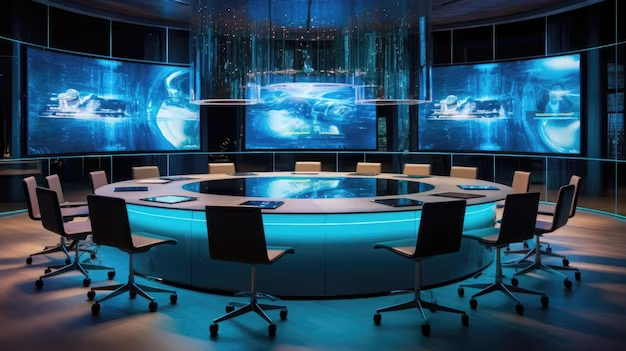The Role Of Audio Visual Solutions In Modern Corporate Communication
Effective communication is the cornerstone of success in the corporate
world. It's the adhesive that binds teams, connects leaders with their
workforce, and establishes the bridge between companies and their clients. In
today's digital age, the landscape of corporate communication has undergone a
remarkable transformation, thanks to the advent of audio-visual technology.
This blog takes you on a journey through the evolving realm of corporate
communication, shedding light on the pivotal role that audio visual solutionsplay in facilitating this modern communication paradigm.
The Evolution of Corporate Communication
Corporate communication, the art of conveying ideas, strategies, and
information within an organization, has a rich historical tapestry. From the
early days of face-to-face meetings and memos to the era of email and
teleconferencing, we've witnessed a profound shift. The evolution of corporate
communication underscores the importance of adapting to changing times. It's a
journey from the limitations of traditional methods to the boundless
possibilities of technology-driven solutions.
Understanding Audio-Visual Technology
Audio-visual technology in the corporate context is akin to a
versatile toolkit, enabling businesses to communicate in a multi-sensory and
interactive way. It encompasses a wide array of components and tools, but two
stars shine particularly bright: video conferencing and webinars.
Video Conferencing: Connecting Teams Worldwide
Picture a world where physical distances pose no barriers to
communication. This is the realm of video conferencing, where colleagues from
different corners of the globe gather in a virtual meeting room. The benefits
are profound:
Enhanced Collaboration: Video
conferencing bridges geographical gaps, promoting collaboration as if teams
were in the same room. It's not just about voice; it's about facial
expressions, body language, and the immediate exchange of ideas.
Cost Savings: The reduced need
for travel translates to substantial cost savings. Companies can allocate
resources more efficiently, and employees can enjoy a better work-life balance.
Team Connectivity: Remote or
dispersed teams can maintain a sense of community and team spirit, thanks to
regular video meetings. It's an essential ingredient in nurturing a strong
corporate culture.
Webinars: Knowledge Sharing and Engagement
Webinars are the stage for knowledge sharing, education, and client
engagement. They empower organizations to connect with a broad audience and
showcase their expertise:
Broad Reach: Webinars have the
capacity to reach a wide and diverse audience, transcending geographical
limitations. They're not just a tool for internal communication but a powerful
means of external engagement.
Marketing and Education: Businesses
leverage webinars for marketing purposes, raising brand awareness and providing
valuable content to clients. They also serve as educational platforms for
employees and customers alike.
Interactive Learning: Webinars
offer a platform for interactive learning, where participants can engage with
presenters, ask questions, and receive real-time feedback.
As we navigate the evolving landscape of corporate communication, it
becomes clear that audio-visual solutions, including video conferencing and
webinars, are the conduits of effective, engaging, and borderless interaction.
They transcend the limitations of physical presence and traditional methods,
ushering in an era where communication knows no boundaries.
Video Conferencing: Connecting Teams Worldwide
In an era of global business operations, the significance of video
conferencing cannot be overstated. It's the virtual bridge that unites teams
separated by vast geographical distances. Here's why it's so vital:
Bridging Geographical Gaps: Video
conferencing transcends borders, enabling seamless communication between team
members, regardless of their physical locations. Colleagues from New York to
Tokyo can share ideas and collaborate in real time.
Face-to-Face in the Virtual Realm: The beauty
of video conferencing lies in its ability to offer face-to-face interactions in
a virtual environment. It's not just about hearing voices; it's about seeing
facial expressions, interpreting body language, and making real connections.
Reduced Travel Costs: The
traditional practice of flying employees to distant locations for meetings is
not only costly but also time-consuming. Video conferencing eliminates the need
for extensive travel, resulting in significant cost savings for companies.
Enhanced Team Connectivity: Imagine a
scenario where team members in different parts of the world meet via video
conference on a regular basis. This promotes a strong sense of team
connectivity and camaraderie. It's the virtual water cooler conversation that
keeps remote or dispersed teams feeling united.
Real-World Success Stories: Take, for
instance, a global tech corporation with research teams scattered across
continents. By integrating video conferencing into their daily communication,
they've reduced research and development timelines, leading to faster product
launches. This not only saves time and money but also fosters innovation.
Webinars: Knowledge Sharing and Engagement
Webinars, short for web seminars, have carved a niche in corporate
communication as versatile platforms for knowledge sharing, education, and
engagement:
Corporate Communication Role: Webinars
are the virtual stages where companies showcase their expertise, reaching a
wide and diverse audience. They serve as avenues for knowledge sharing and
training, creating a strong educational foundation.
Broad Audience Reach: One of the
standout features of webinars is their ability to connect with a large and
geographically dispersed audience. This is invaluable for companies looking to
broaden their reach beyond physical boundaries.
Marketing and Education: Successful
businesses leverage webinars for both marketing and education. They're a tool
for promoting products or services while providing valuable content to clients.
This dual role enhances engagement and trust.
Real-World Success Stories: Consider a
financial institution that regularly conducts webinars on financial literacy.
These online sessions not only provide clients with valuable knowledge but also
position the institution as an authority in the field. This has led to
increased client retention and new customer acquisition.
The Impact on Corporate Culture
The influence of audio-visual technology on corporate culture is
profound:
Fostering Open Communication:
Audio-visual technology nurtures a culture of open and transparent
communication within organizations. Video conferencing and webinars make it
easy for employees to engage in discussions, ask questions, and share ideas,
regardless of their physical locations.
Team Building and Community: Video
conferencing is not just a business tool; it's a team-building asset. It
maintains a sense of community among remote or dispersed teams, creating a
virtual space where colleagues can bond and collaborate. This sense of
community contributes to a strong corporate culture.
Internal Knowledge Sharing: Webinars
serve as platforms for internal knowledge sharing and professional development.
They enable subject matter experts within the company to share their insights
and expertise, fostering a culture of learning and growth.
Overcoming Challenges and Maximizing Benefits
While audio-visual technology in corporate communication offers a
plethora of benefits, it's not without its challenges. Let's delve into how
organizations can navigate these hurdles and maximize the advantages:
Common Challenges: Implementing
audio-visual technology may come with technical issues like connectivity
problems or software glitches. Security concerns, such as data breaches or
unauthorized access, can also be worrisome. These challenges can hinder the
seamless adoption of technology.
Strategies and Best Practices: To
overcome these challenges, organizations should focus on robust training
programs to ensure employees are comfortable with the technology. Regular
maintenance and updates can address technical issues. Security protocols should
be stringent, and encryption methods employed to safeguard sensitive
information. It's also important to have a contingency plan in place for any
unexpected issues.
Maximizing Benefits: To fully
capitalize on the benefits of video conferencing and webinars, organizations
should encourage active participation and engagement. This can be achieved by
promoting interactive sessions, providing access to recorded content, and
ensuring a user-friendly interface. Companies should also explore features like
breakout rooms for smaller discussions, enhancing the collaborative experience.
Future Trends in Corporate Communication
The landscape of corporate communication is ever-evolving, with
exciting trends on the horizon:
Virtual Reality (VR): Virtual
reality is set to revolutionize corporate communication by creating immersive
experiences. VR can be used for virtual meetings, training sessions, and even
product demonstrations, offering a new level of interactivity and engagement.
Augmented Reality (AR): Augmented
reality overlays digital content onto the real world. In corporate settings, AR
can enhance presentations, provide real-time data visualization, and even
assist with remote troubleshooting.
AI-Driven Solutions: Artificial
intelligence is making waves in corporate communication. AI can automate
routine tasks, provide data analytics for decision-making, and even facilitate
chatbots for customer service and internal queries.
Voice-Activated Systems:
Voice-activated systems, like smart speakers, are being integrated into
corporate environments to enhance communication efficiency. They enable
hands-free control of audio-visual equipment and can schedule meetings or
provide information through voice commands.
In closing, the role of audio-visual technology in modern corporate
communication cannot be understated. It is the dynamic force propelling
businesses into the future of seamless communication, connectivity, and
collaboration. By embracing video conferencing and webinars, organizations can
transcend geographic constraints and nurture a culture of inclusivity and
innovation.
In the face of challenges, companies must invest in training,
maintenance, and robust security measures to ensure a smooth transition. To
maximize benefits, fostering active participation and exploring interactive
features is key.
The future holds even more exciting prospects, with virtual reality,
augmented reality, AI-driven solutions, and voice-activated systems poised to
shape the corporate communication landscape. Embracing these technologies will
keep businesses at the forefront of efficient and engaging communication.
Frequently Asked Questions (FAQs)
What are the common technical challenges in implementing audio-visual
solutions in corporate settings?
Common technical challenges include connectivity issues, software
glitches, and compatibility problems. These can disrupt the smooth operation of
audio-visual technology.
How can companies ensure the security of audio-visual communication
and data in corporate environments?
To ensure security, companies should employ strong encryption methods,
implement access controls, and regularly update security protocols. It's also
important to educate employees on best security practices.
What are some best practices for maximizing the benefits of video
conferencing and webinars in corporate communication?
Best practices include promoting active participation, providing
access to recorded content, and ensuring a user-friendly interface. Interactive
features like breakout rooms can enhance the collaborative experience.
What trends in audio-visual technology are expected to shape the
future of corporate communication?
Future trends include the use of virtual reality (VR), augmented
reality (AR), AI-driven solutions, and voice-activated systems to enhance
communication, training, and customer service in corporate environments.





Comments
Post a Comment